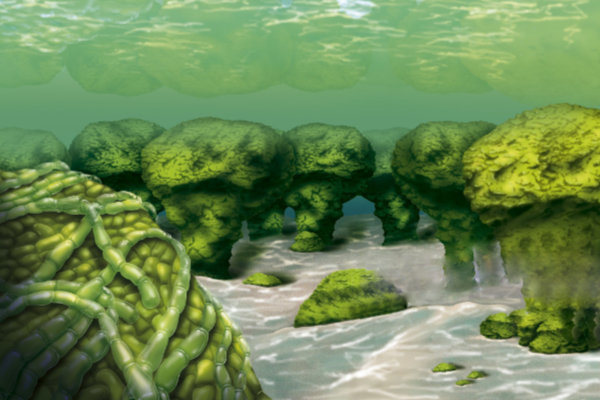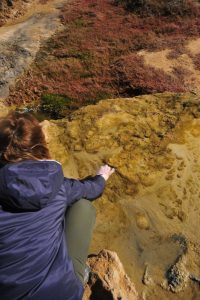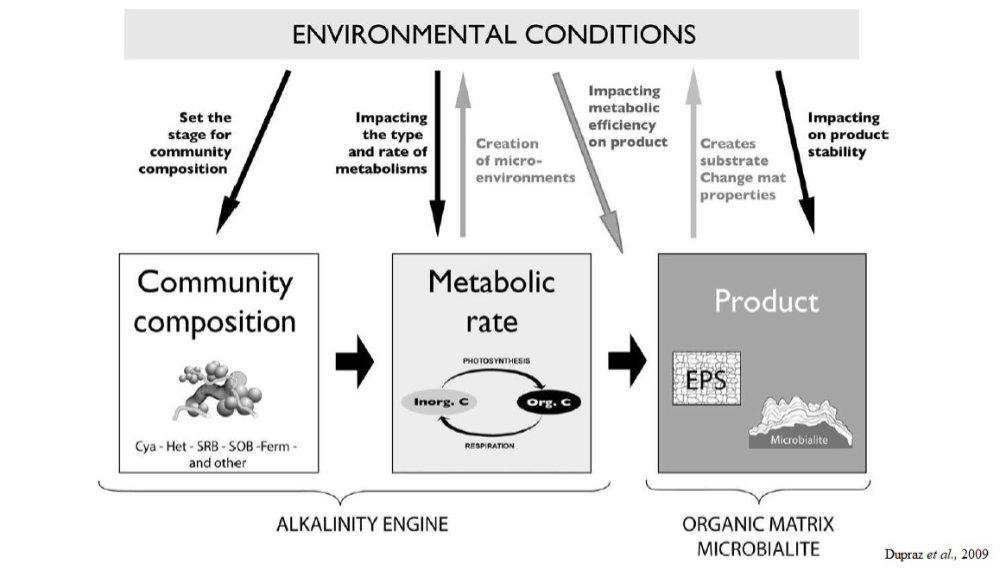Marlisa de Brito PhD thesis
 The role of cyanobacterial extracellular polymeric substances (EPS) in carbonate precipitation
The role of cyanobacterial extracellular polymeric substances (EPS) in carbonate precipitation
Started in September 2019
Funding: ISITE project
Supervisor: Pieter Visscher ; cosupervisor: Irina Bundeleva
Defended the 29 september 2023
Abstract
Cyanobacteria are major contributors to the precipitation of minerals forming biogenic carbonates through microbially-mediated mineralization processes (often called ‘organomineralization’). Their photosynthetic activity increases pH, favoring CaCO3 precipitation. Additionally, these phototrophs produce copious amounts of exopolymeric substances (EPS) which can carry a net negative electric charge and have the capacity to bind metal ions including Ca2+, initially inhibiting precipitation. Upon alteration (including degradation) of EPS, Ca2+ is released and can precipitate as calcium carbonate. Alternatively, the Ca2+ bound on EPS can precipitate on the organic matrix. EPS properties are the result of its production and consumption and, thus, change constantly. Environmental conditions (e.g., including pH) impact the charger and binding capacity of EPS and consequently influence the properties of CaCO3 crystals. The main objective of this thesis is to characterize and understand the role of cyanobacterial EPS in carbonate precipitation. For that, cyanobacterial growth patterns, quantity and quality of EPS produced were investigated as well as the effect of EPS produced in carbonate mineral formation in the laboratory (in vitro) and in the natural system (in situ).
 The current paradigm is that in microbial mats and microbialites, microbially-induced precipitation of minerals is the most important mechanism. Two factors play a role in this: the first is a change in alkalinity that results from the metabolic reactions of the entire microbial community (as outlined above, cyanobacteria play a predominant role in this). The potential to change the local alkalinity, either favoring precipitation or dissolution, is referred to as the alkalinity engine. Metabolisms change with the time of the day, and both light and dark conditions need to be studied. The second factor is the quantity and biochemical propriety of the exopolymeric substance (EPS) produced by microorganisms. Microbial cell surface and EPS, which carry a net negative electric charge and have the capacity to bind metal ions including Ca2+, initially inhibiting precipitation. Upon alteration (including degradation) of EPS, Ca2+ is released and can precipitate as carbonate. Alternatively, the EPS-bound calcium can precipitate on the organic matrix. EPS properties are the result of its production and consumption and, consequently, change constantly. It should be noted that small organic acids – low molecular weight organic compounds (LMWOC; e.g. lactate, acetate) – play a similar role as what is outlined above for EPS. As an example of this process, Dupraz et al. (2004) observed calcium carbonate precipitation on EPS by cyanobacteria.
The current paradigm is that in microbial mats and microbialites, microbially-induced precipitation of minerals is the most important mechanism. Two factors play a role in this: the first is a change in alkalinity that results from the metabolic reactions of the entire microbial community (as outlined above, cyanobacteria play a predominant role in this). The potential to change the local alkalinity, either favoring precipitation or dissolution, is referred to as the alkalinity engine. Metabolisms change with the time of the day, and both light and dark conditions need to be studied. The second factor is the quantity and biochemical propriety of the exopolymeric substance (EPS) produced by microorganisms. Microbial cell surface and EPS, which carry a net negative electric charge and have the capacity to bind metal ions including Ca2+, initially inhibiting precipitation. Upon alteration (including degradation) of EPS, Ca2+ is released and can precipitate as carbonate. Alternatively, the EPS-bound calcium can precipitate on the organic matrix. EPS properties are the result of its production and consumption and, consequently, change constantly. It should be noted that small organic acids – low molecular weight organic compounds (LMWOC; e.g. lactate, acetate) – play a similar role as what is outlined above for EPS. As an example of this process, Dupraz et al. (2004) observed calcium carbonate precipitation on EPS by cyanobacteria.
 In sum, the precipitation and growth of organominerals is a complex process that is controlled by three main factors: (1) environmental physicochemical conditions; (2) metabolic activity of microorganisms inducing local geochemical changes; (3) production and consumption of extracellular organic matter (including LMWOC and EPS) by bacteria. The interaction of these three factors is critical for organomineralization processes.
In sum, the precipitation and growth of organominerals is a complex process that is controlled by three main factors: (1) environmental physicochemical conditions; (2) metabolic activity of microorganisms inducing local geochemical changes; (3) production and consumption of extracellular organic matter (including LMWOC and EPS) by bacteria. The interaction of these three factors is critical for organomineralization processes.
The objective of this thesis is characterizing and understanding the role of cyanobacteria and organic matter (EPS and LMWOC) produced during carbonate precipitation. For that, cyanobacterial strains with different morphology, growth rate and quantity and quality of EPS production will be investigated.
The results will be used to relate the specific cyanobacterial morphology and the properties of cyanobacterial EPS to calcium carbonate precipitation and to create conceptual models describing mechanisms of organomineralization in modern and ancient microbialites systems. The identification the cyanobacterial metabolism, which conditions may promote carbonate precipitation and allow conservation of microbial carbonate deposits, can help us to explain why some mats can lithify and others not and provide clues to access the biogenicity in the fossil record. We attempt to link the experimental results to observations in relict and fossil microbialite samples.
Keywords
Geomicrobiology, organomineralization, cyanobacteria, carbonate precipitation, organic matter, microbial mats, Microscopy and Spectroscopy
Thesis advisory panel
Annick Wilmotte
Frédéric Marin
Jury
Emmanuel Fara, université de Bourgogne – president
Maria Dittrich, université de Toronto – reviewer
Olivier Braissant, université de Bâle – reviewer
Bénédict Menez, université Paris 6, IPGP – examiner
RaphaëBourillot l, INP Bordeaux – examiner
Frédéric Marin, laboratoire Biogéosciences, UBFC – invited
Emmanuelle Vennin, université de Bourgogne – invited
Pieter T.Visscher, University of Connecticut, USA; UBFC – supervisor
Irina Bundeleva, université de Bourgogne – cosupervisor
- extrait:
- lien_externe:
- kc_data:
- a:8:{i:0;s:0:"";s:4:"mode";s:0:"";s:3:"css";s:0:"";s:9:"max_width";s:0:"";s:7:"classes";s:0:"";s:9:"thumbnail";s:0:"";s:9:"collapsed";s:0:"";s:9:"optimized";s:0:"";}
- kc_raw_content:
 The role of cyanobacterial extracellular polymeric substances (EPS) in carbonate precipitation
The role of cyanobacterial extracellular polymeric substances (EPS) in carbonate precipitationStarted in September 2019
Funding: ISITE project
Supervisor: Pieter Visscher ; cosupervisor: Irina Bundeleva
Defended the 29 september 2023
Abstract
Cyanobacteria are major contributors to the precipitation of minerals forming biogenic carbonates through microbially-mediated mineralization processes (often called ‘organomineralization’). Their photosynthetic activity increases pH, favoring CaCO3 precipitation. Additionally, these phototrophs produce copious amounts of exopolymeric substances (EPS) which can carry a net negative electric charge and have the capacity to bind metal ions including Ca2+, initially inhibiting precipitation. Upon alteration (including degradation) of EPS, Ca2+ is released and can precipitate as calcium carbonate. Alternatively, the Ca2+ bound on EPS can precipitate on the organic matrix. EPS properties are the result of its production and consumption and, thus, change constantly. Environmental conditions (e.g., including pH) impact the charger and binding capacity of EPS and consequently influence the properties of CaCO3 crystals. The main objective of this thesis is to characterize and understand the role of cyanobacterial EPS in carbonate precipitation. For that, cyanobacterial growth patterns, quantity and quality of EPS produced were investigated as well as the effect of EPS produced in carbonate mineral formation in the laboratory (in vitro) and in the natural system (in situ).
 The current paradigm is that in microbial mats and microbialites, microbially-induced precipitation of minerals is the most important mechanism. Two factors play a role in this: the first is a change in alkalinity that results from the metabolic reactions of the entire microbial community (as outlined above, cyanobacteria play a predominant role in this). The potential to change the local alkalinity, either favoring precipitation or dissolution, is referred to as the alkalinity engine. Metabolisms change with the time of the day, and both light and dark conditions need to be studied. The second factor is the quantity and biochemical propriety of the exopolymeric substance (EPS) produced by microorganisms. Microbial cell surface and EPS, which carry a net negative electric charge and have the capacity to bind metal ions including Ca2+, initially inhibiting precipitation. Upon alteration (including degradation) of EPS, Ca2+ is released and can precipitate as carbonate. Alternatively, the EPS-bound calcium can precipitate on the organic matrix. EPS properties are the result of its production and consumption and, consequently, change constantly. It should be noted that small organic acids – low molecular weight organic compounds (LMWOC; e.g. lactate, acetate) – play a similar role as what is outlined above for EPS. As an example of this process, Dupraz et al. (2004) observed calcium carbonate precipitation on EPS by cyanobacteria.
The current paradigm is that in microbial mats and microbialites, microbially-induced precipitation of minerals is the most important mechanism. Two factors play a role in this: the first is a change in alkalinity that results from the metabolic reactions of the entire microbial community (as outlined above, cyanobacteria play a predominant role in this). The potential to change the local alkalinity, either favoring precipitation or dissolution, is referred to as the alkalinity engine. Metabolisms change with the time of the day, and both light and dark conditions need to be studied. The second factor is the quantity and biochemical propriety of the exopolymeric substance (EPS) produced by microorganisms. Microbial cell surface and EPS, which carry a net negative electric charge and have the capacity to bind metal ions including Ca2+, initially inhibiting precipitation. Upon alteration (including degradation) of EPS, Ca2+ is released and can precipitate as carbonate. Alternatively, the EPS-bound calcium can precipitate on the organic matrix. EPS properties are the result of its production and consumption and, consequently, change constantly. It should be noted that small organic acids – low molecular weight organic compounds (LMWOC; e.g. lactate, acetate) – play a similar role as what is outlined above for EPS. As an example of this process, Dupraz et al. (2004) observed calcium carbonate precipitation on EPS by cyanobacteria.
 In sum, the precipitation and growth of organominerals is a complex process that is controlled by three main factors: (1) environmental physicochemical conditions; (2) metabolic activity of microorganisms inducing local geochemical changes; (3) production and consumption of extracellular organic matter (including LMWOC and EPS) by bacteria. The interaction of these three factors is critical for organomineralization processes.
In sum, the precipitation and growth of organominerals is a complex process that is controlled by three main factors: (1) environmental physicochemical conditions; (2) metabolic activity of microorganisms inducing local geochemical changes; (3) production and consumption of extracellular organic matter (including LMWOC and EPS) by bacteria. The interaction of these three factors is critical for organomineralization processes.The objective of this thesis is characterizing and understanding the role of cyanobacteria and organic matter (EPS and LMWOC) produced during carbonate precipitation. For that, cyanobacterial strains with different morphology, growth rate and quantity and quality of EPS production will be investigated.
The results will be used to relate the specific cyanobacterial morphology and the properties of cyanobacterial EPS to calcium carbonate precipitation and to create conceptual models describing mechanisms of organomineralization in modern and ancient microbialites systems. The identification the cyanobacterial metabolism, which conditions may promote carbonate precipitation and allow conservation of microbial carbonate deposits, can help us to explain why some mats can lithify and others not and provide clues to access the biogenicity in the fossil record. We attempt to link the experimental results to observations in relict and fossil microbialite samples.
Keywords
Geomicrobiology, organomineralization, cyanobacteria, carbonate precipitation, organic matter, microbial mats, Microscopy and Spectroscopy
Thesis advisory panel
Annick Wilmotte
Frédéric MarinJury
Emmanuel Fara, université de Bourgogne – president
Maria Dittrich, université de Toronto – reviewer
Olivier Braissant, université de Bâle – reviewer
Bénédict Menez, université Paris 6, IPGP – examiner
RaphaëBourillot l, INP Bordeaux – examiner
Frédéric Marin, laboratoire Biogéosciences, UBFC – invited
Emmanuelle Vennin, université de Bourgogne – invited
Pieter T.Visscher, University of Connecticut, USA; UBFC – supervisor
Irina Bundeleva, université de Bourgogne – cosupervisor- titre:
- The role of cyanobacteria in carbonate precipitation
- date_de_debut_these:
- septembre 2019
- nom:
- de Brito
- date_de_debut_these_numerique:
- 201909


